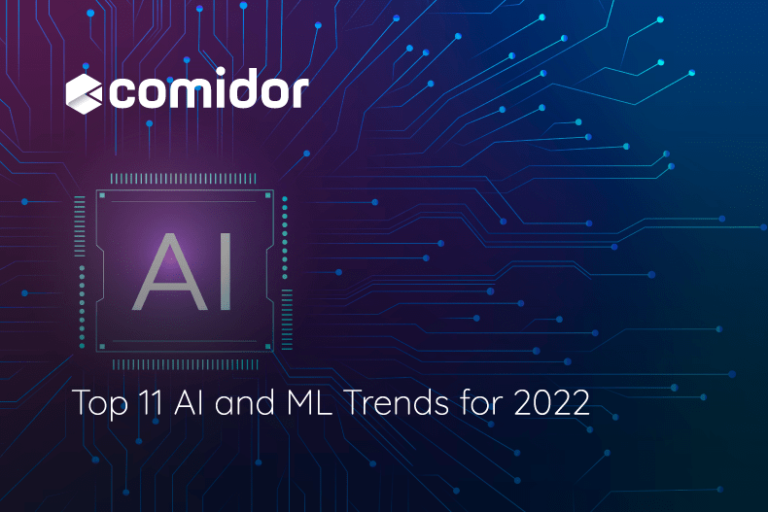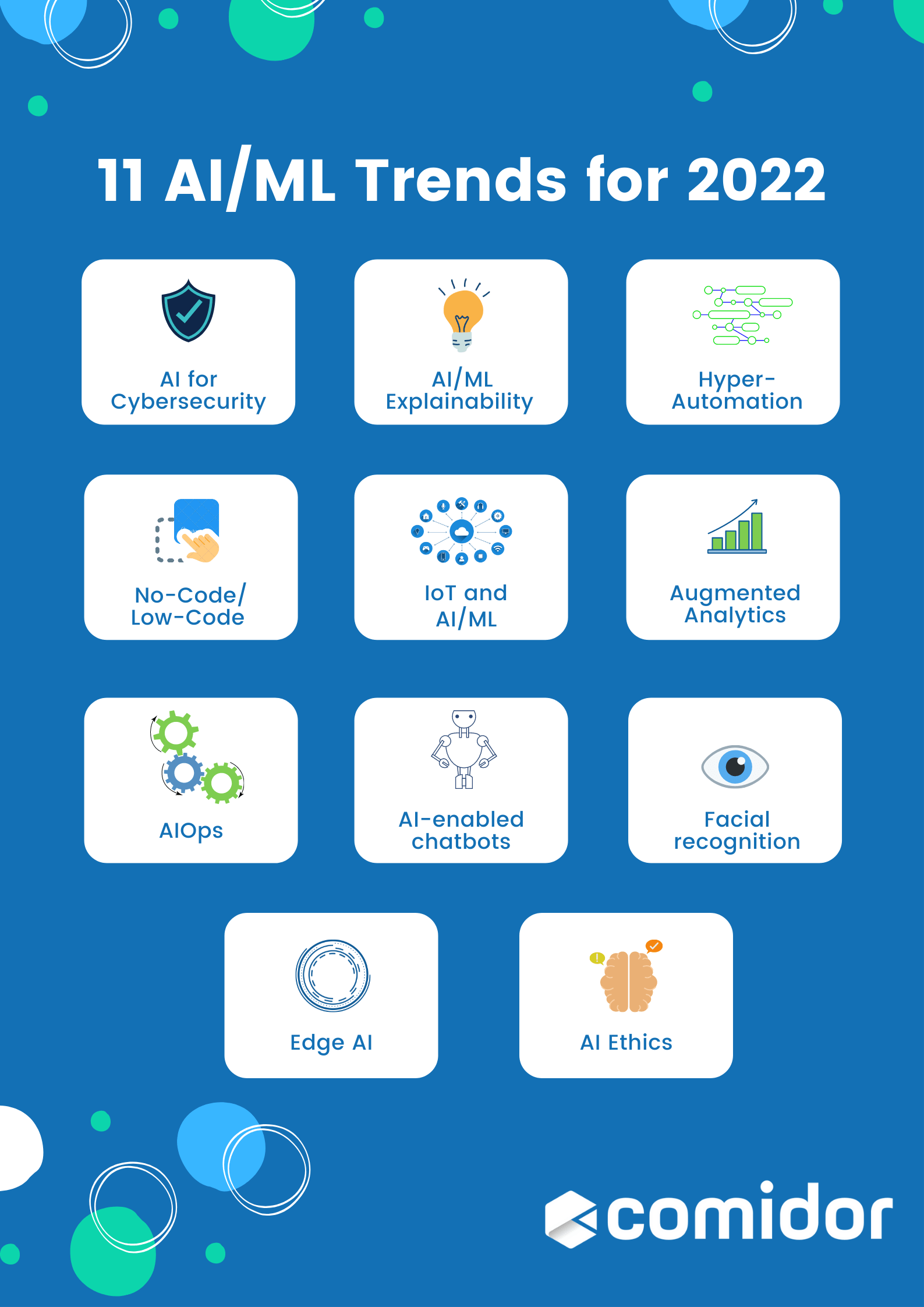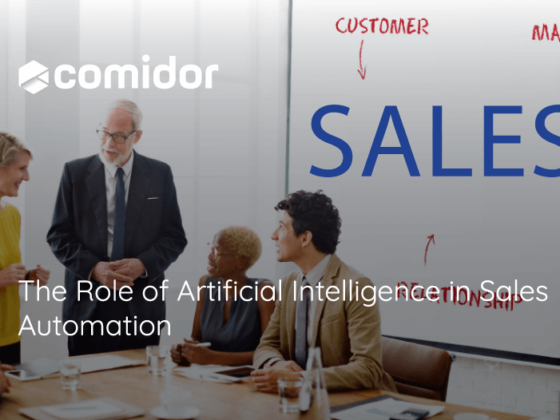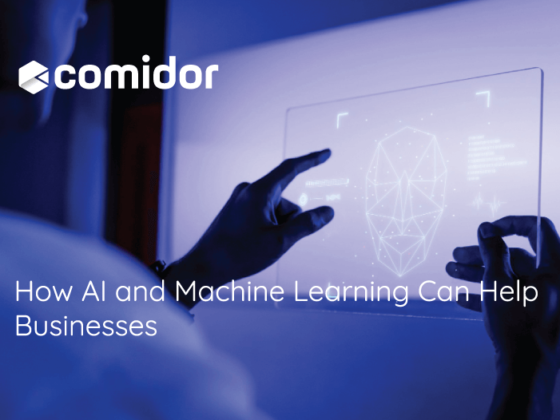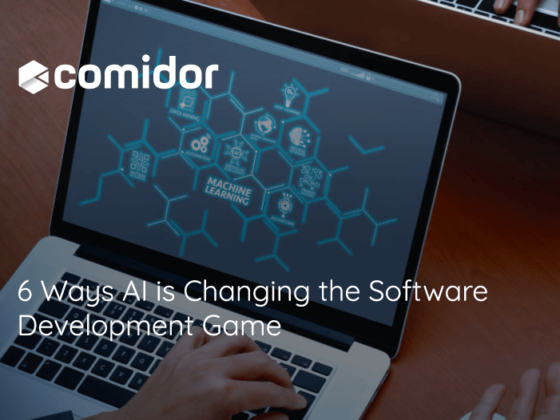The COVID-19 pandemic has changed how organizations operate and spurred the automation of their core business processes. During this unprecedented era, the interest in AI ML trends has grown significantly. According to a McKinsey survey, published in November 2020 at least half of the organizations have adopted AI functions in their organization.
As most companies aim to automate their processes and technology becomes part of daily life, Artificial Intelligence (AI) and Machine Learning (ML) have taken center stage in solving business problems. These advanced technologies can change undoubtedly how businesses operate and how employees will work in the near future. According to Stanford University report, spending on Artificial Intelligence and Machine Learning will increase to $97.9 billion by 2023 and it’s expected to reach $299.64 billion in 2026. Companies need to keep an eye on these cutting-edge technologies that show a tremendous rise. Here are the top 11 AI ML trends you should expect in 2022 and beyond. 
1. Artificial Intelligence for Cybersecurity
Cybersecurity is an integral part of advanced technologies and digital transformation. As organizations seek new ways to safeguard their digital spaces, Artificial Intelligence will increasingly be part of cybersecurity solutions. If harnessed correctly, Artificial Intelligence solutions can resolve critical safety issues and malfunctions, and identify cyber threats that may set businesses at high risk.
What’s more, Artificial Intelligence can be used to collect data from a company’s software systems and external sources and utilize algorithms to establish patterns to avoid auspicious activities. Artificial Intelligence will, therefore, help identify existing hazards and variants of previous threats. The use of AI will significantly reduce downtime, boost efficiency and allow cybersecurity teams to focus on other critical issues.
2. AI and ML Explainability
As more businesses and organizations integrate Artificial Intelligence and Machine Learning in their operations, there is an important need to make these cutting-edge technologies more transparent and explainable. Data regulations, privacy requirements, and a focus on AI bias will call for more AI transparency.
White-box models have more interpretable features that will help organizations stay accountable and compliant to data laws and privacy requirements.
With these models, businesses can have a clear overview of how AI and ML models behave, come up with predictions and the variables they use. They, therefore, make AI and ML more explainable and transparent. More organizations will adopt white-box models to empower their teams to implement AI projects confidently and inspire trust.
3. Hyper-Automation technologies
With remote work becoming the norm during the pandemic, the need for advanced process automation in businesses continues to rise. Based on Deloitte’s survey it was found that “58% of surveyed executives report they have started their intelligent automation journey”. Gartner estimates that by 2024, organisations will lower operational costs by 30% by combining Hyper-Automation technologies with redesigned operational processes”.
AI-enabled automation will lead to new innovations as it aims to improve the decision-making, organizational efficiency and create deeper data-based insights. What’s more, organizations won’t have to invest in data science teams due to the availability of automated machine learning platforms that allow for quick and effective AI implementation.
Hyper-Automation software powered by AI and ML and Robotic Process Automation (RPA), can automate repetitive tasks and processes, provide deep insights to companies through advanced analytics and lead to end-to-end automation. These tools enable organizations to connect data, processes, and people to improve their workflow efficiency. All while decreasing their operational expenses and improving employees’ productivity.
4. Democratization of AI ML trends with No-Code/Low-Code
Democratization of Artificial Intelligence means making it accessible to other parties besides data scientists that can help boost a business. As companies seek to gain more value from Artificial Intelligence and Machine Learning, they will empower teams, including operational and management teams, with analytical capabilities. To achieve democratization, organizations will use No-Code/Low-Code AI that doesn’t require programming skills.
While AI and ML technologies automate and optimize business processes from start to finish, No-Code-Low-Code platforms can significantly accelerate the digital automation journey by minimizing the time it takes to maintain, upgrade, and enhance all the implemented technologies.
Low-Code provides an easy visual model-driven environment for professional and non-professional developers, to facilitate and accelerate the development of advanced AI and ML models. Most No-Code/Low-Code platforms have easy-to-use drag and drop tools to suit non-tech individuals.
5. Combination of Internet of Things (IoT) and AI and ML
Although the Internet of Things (IoT) is an established technology on its own, it will increasingly intersect with Machine Learning and Artificial Intelligence. IoT connects multiple devices over a network and allows them to communicate and exchange a tremendous amount of data. The devices collect a lot of valuable information that can be useful in decision-making.
In addition to that, Artificial Intelligence and Machine Learning will play a significant role in analyzing data that IoT devices collect, to provide deep insights and actionable results. For example, sensors can help collect data on vehicle emissions and traffic levels, and Machine Learning will use algorithms to find the best ways to reduce pollution, as is with the Green Horizons project. According to experts’ predictions, projects using IoT and AI and ML will increase to 80% by 2022.
“Artificial Intelligence and Machine Learning have reached a critical tipping point and will increasingly augment and extend virtually every technology enabled service, thing, or application.” Gartner
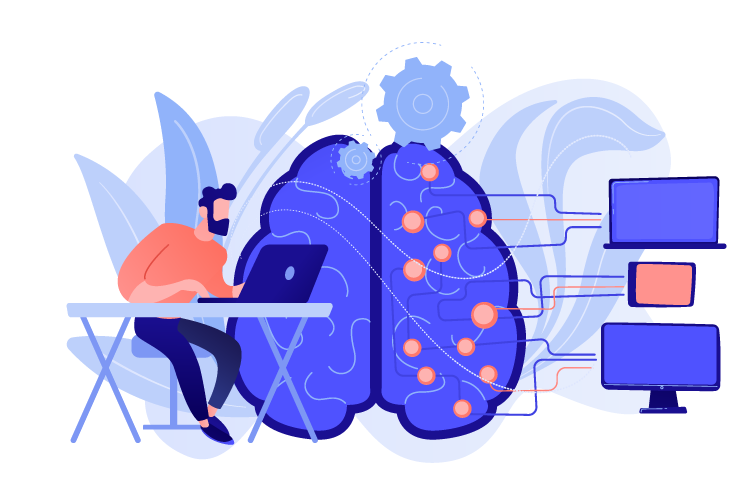 6. Augmented Analytics
6. Augmented Analytics
Artificial intelligence (AI) is a crucial, powerful technology that is steadily being implemented into all core business processes. As organizations are searching for new opportunities to optimize their workflows, they invest in data analysts to create and count on powerful AI and ML models.
Augmented analytics will change how businesses gain and analyze data to make predictions and reach decisions. Augmented intelligence comes from the combination of machine learning with human thinking and turns perceptions into conclusions and actions.
This type of software utilizes Machine Learning and Natural Language Processing (NLP) to perform large-scale data analysis as humans would do. The analysts use data from public or private databases and then share their insights with organizations together with a strategic plan.
One business implementation example is Coca-Cola, which adopted AI-driven image recognition technology & augmented analytics to help analyze the data of how their products are published and represented on social media.
7. AIOps
Industry experts consider AIOps to be the future trend of IT operations. According to IBM, “AIOps uses artificial intelligence to simplify IT operations management and accelerate and automate problem resolution in complex modern IT environments”.
All applications and software systems produce a huge amount of data. In general, AIOps uses big data, Artificial Intelligence, Machine Learning, and advanced analytics to collect this enormous amount of IT operations data that come from apps and performance-auditing solutions. Then, this data is used to identify patterns, events, and performance issues.
IT experts from Gill Benefits claim that “AIOps enables IT, teams, to resolve critical issues quickly, minimizing downtime and outages.”
This technology simplifies the IT operations that are difficult to be monitored while at the same time ensures that users experience little to no interruptions while using systems and applications.
8. AI-enabled chatbots
Chatbots and Conversational AI market is expected to reach $4.5 billion by 2021. Chatbots is another AI technology that is improving significantly the customer experience by quickly answering their questions and fixing their issues. Businesses that use chatbots offer a more convenient experience to their clients. These agents are always available and automate the whole communication between the business and the clients. Besides the informative or conversational chatbots, there are the transactional chatbots that make a transaction within the context of a conversation.
Transactional chatbots can be used in various industries such as finance, and e-commerce. In Finance, for example, they can automate simple tasks that otherwise needed a bank agent. These type of tasks include identity verification, payment confirmation etc. In the e-commerce industry, a transactional chatbot can help users to find what they are searching for, and eventually make a purchase. It can also be used to change or cancel an order if it’s needed.
The benefits for the businesses are obvious. The implementation of chatbots will create a certain amount of cost reductions. Bots can also improve the sales process due to their 24/7 availability and instant responses.
Leia, the Comidor’s intelligent virtual agent, is an AI-enabled chatbot that helps employees and teams work smarter, remotely, and more efficiently. This chatbot can significantly improve employees’ experience during their day-to-day duties. It can assist them in a more natural, more engaging, and ultimately, more human way. The employee simply asks questions and Leia responds with specific data and useful resources.
9. Popularization of facial recognition
Facial recognition is one of the most popular implementations of Artificial Intelligence. The technological development that takes place the recent years has led to a wide adoption of this technology.
In the healthcare industry, facial analysis can vitally help with the diagnosis of diseases. Sophisticated algorithms are a crucial diagnostic tool for disorders that cause noticeable changes in physical appearance. In education, it can be used to attend track students’ attendance in schools. Devices are being used to scan students’ faces and compare their photos with database records to confirm their identities.
In the next years, we will also experience the rise of business applications that rely on facial recognition to allow many types of transactions (bank transactions, public institution identifications, store purchases etc.).
10. Edge AI
In general, Edge AI combines Edge Computing and Artificial Intelligence into one system and enables data processing using local smart devices and powerful servers. Edge AI devices can be smart speakers, smartphones, computers, robots, smart cars, and high-resolution cameras. The massive advantage of this technology is that it doesn’t require an internet connection to analyze this huge amount of data.
Another major benefit of Edge AI is the real-time data processing. AI edge computing makes it possible to perform AI applications directly on field devices . This results in response time reduction, which in some cases is extremely needed (for example sending warning messages in autonomous cars).
Also, Edge AI ensures safe data analysis since the data processing is performed locally in each edge computer.
11. AI Ethics
With this wide adoption of Artificial Intelligence, it’s essential for businesses to focus on data integrity, a critical factor for efficient and ethical use of AI technologies. Several leading IT global leaders, including Microsoft, IBM, and Amazon, decided to limit the use of their facial recognition models by police departments in the US, focusing on a range of ethical questions around the increasing use of AI.
The lack of AI ethics adoption can be a real threat to the company. It might increase regulatory, legal and brand identity risks. Also, it can lead to production inefficiencies and wasted resources.
Almost 9 in 10 (89%) executives believe ethical considerations before and during the AI implementation result in a competitive advantage for businesses.
Bottom Line
AI ML trends gravitate towards improving and automating business processes end-to-end. It’s indisputable that these cutting-edge technologies are becoming the key technology trends for 2022.
From AlOps to Hyper-Automation, AI is going to impact every business aspect significantly. Organizations must look into the latest trends of Artificial Intelligence and Machine learning, research, and adopt an ideal intelligent solution for their business to scale and differentiate.
Achieve fast and agile Hyper-Automation with Comidor
Our innovative Low-Code Hyper-Automation platform can streamline and automate all your business processes. Automate your workflows with the latest trends in AI and ML and build advanced business applications with ease.
Schedule your Comidor demo today to learn how our powerful solution can automate your current business processes and lead to significant cost reduction and productivity improvement.
Achieve end-to-end intelligent automation with Comidor


